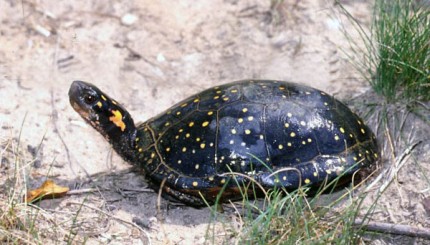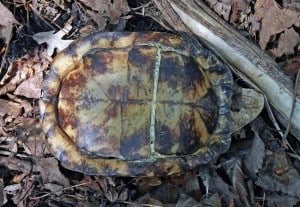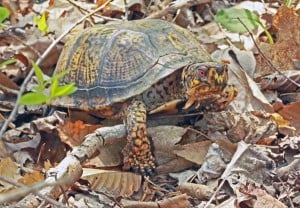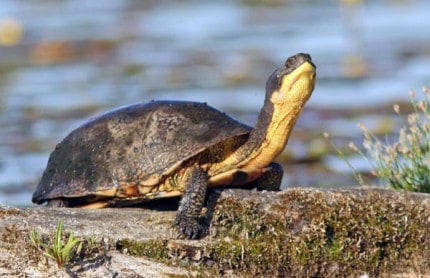
(Chelsea Update would like to thank Tom Hodgson and the Waterloo Natural History Association for the information and photos in this column.)
The fen at Park Lyndon, the Nan Weston Preserve and the Waterloo and Pinckney Recreation Areas all provide important wetland habitats for three native turtles with declining populations.
Michigan once boasted 11 million acres of wetlands including swamps, marshes, fens and bogs. Thanks largely to draining for agriculture and development, only about three million acres remain. Many wetland-loving plants and animals have paid the price, some to the point of extinction. In spite of new laws to protect wetlands, they are still disappearing, although at a slower rate.
In the Chelsea area, we are fortunate to have state, county and private parks and preserves, that protect many of our local wetlands and provide safe haven for a fascinating array of wildlife species including three uncommon turtles.

The spotted turtle is the rarest of the three and is considered a threatened species in Michigan. It inhabits soft-bottomed wetlands including marshy lake borders, fens and bogs. It is a small, shy turtle with a shell length of only about 4-and-a-half inches. Its population has been reduced to widely scattered, isolated colonies mostly in Southern Lower Michigan. Habitat loss and illegal collecting for the pet trade are the primary reasons for their decline.
The Waterloo Recreation Area is home to at least one spotted turtle colony.
The eastern box turtle is the only turtle in Michigan that can completely withdraw into its shell. A hinge on the lower shell allows it to close tightly against the upper shell, completely concealing legs head and tail. This provides an obvious survival advantage, which may be the reason that some box turtles have been known to live over 100 years.
Their longevity also makes it difficult to know if adult individuals found in the wild are part of a viable breeding population or just a few lonesome remnants living out their long lives without ever finding another of their kind.
The box turtle is also Michigan’s only terrestrial turtle. It will visit shallow wetlands and streams, but is an awkward swimmer.
There has been one adult box turtle reported in the Waterloo Recreation Area in the last 40 years. Individuals have been spotted in the Nan Weston Preserve with greater frequency.

Box turtles hibernate under the leaf litter on the forest floor, and are more numerous on the western side of the state where lake-effect snows help to insulate them from the cold winter temperatures. Box turtles are considered a species of special concern in Michigan and are protected by law. The biggest reason for their decline is the reduction of woodland habitat and illegal collecting for the pet trade. Male box turtles like the one pictured in this article have a bright, red eye. The eye of the female is brown. Box turtles may grow to a shell length of nearly 8 inches.
The Blanding’s turtle, the third and largest turtle in the group, named in honor of American naturalist William Blanding, may have a shell length over 10 inches. Its high domed shell resembles that of a box turtle, but is only partially hinged. It is, in fact, sometimes confused with the box turtle, but its size and bright yellow chin and throat is makes for positive identification.
This is a turtle of shallow wetlands that has suffered greatly from habitat loss throughout its range. Michigan is currently its last stronghold. Because of the abundance of protected wetlands in our area it may seem quite common. It is, however, still a species of special concern in Michigan and is protected by law.
Michigan law prohibits the collecting or possession of any of these three species. All native turtles are best left in the wild where they can contribute to the breeding population.
What can you do to help Michigan turtles? Leave them in the wild, and be alert during breeding and egg laying season in May and June when many venture over local roads looking for mates or suitable nesting sites.











